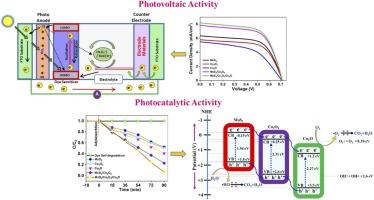当前位置:
X-MOL 学术
›
J. Alloys Compd.
›
论文详情
Our official English website, www.x-mol.net, welcomes your
feedback! (Note: you will need to create a separate account there.)
Synergistic effects in MoS2/Co3O4/Cu2O nanocomposites for superior solar cell and photodegradation efficiency
Journal of Alloys and Compounds ( IF 5.8 ) Pub Date : 2024-11-20 , DOI: 10.1016/j.jallcom.2024.177672 D. Karthigaimuthu, Arjun Kumar Bojarajan, Elangovan Thangavel, Pardha Saradhi Maram, Sasirekha Venkidusamy, Sambasivam Sangaraju, Abdel-Hamid I. Mourad
Journal of Alloys and Compounds ( IF 5.8 ) Pub Date : 2024-11-20 , DOI: 10.1016/j.jallcom.2024.177672 D. Karthigaimuthu, Arjun Kumar Bojarajan, Elangovan Thangavel, Pardha Saradhi Maram, Sasirekha Venkidusamy, Sambasivam Sangaraju, Abdel-Hamid I. Mourad

|
Herein, we synthesized a Cu2 O and Co3 O4 incorporation with MoS2 to produce MoS2 /Co3 O4 /Cu2 O nanocomposites by facile sonication assisted hydrothermal methods. The phase structure and elemental composition of MoS2 /Co3 O4 /Cu2 O nanocomposites were investigated using X-ray diffraction (XRD) and X-ray photoelectron spectroscopy (XPS) techniques. Scanning electron microscopy (SEM) and transmission electron microscopy (TEM) morphology studies confirm that MoS2 /Co3 O4 nanostructure self-assembles in a mixed nanosheet configuration after the introduction of Cu2 O. The synthesized samples were used as new types of Pt-free counter electrodes (CE) for DSSCs. Among all, the DSSCs based on the MoS2 /Co3 O4 /Cu2 O CE yields a maximum power conversion efficiency of 3.68 % (Jsc = 8.2 mA cm−2 , Voc = 0.71 mV and FF = 0.629 %) under the standard AM 1.5 G illumination, which is 2.5 times higher than that of pure MoS2 . To assess the photocatalytic activity, prepared samples were used to suppress methylene blue (MB) and rhodamine B (RhB) dye under UV–visible light irradiation. The MoS2 /Co3 O4 /Cu2 O nanocomposites had the highest photocatalytic degradation efficiency of all the samples. It increased degradation efficiency from 43 % to 91 % for MB dye after 100 minutes, and from 47 % to 92 % for RhB dye after 90 minutes. Scavengers test analysis proved that the superoxide radical (•O2 − ) play a major role in the MoS2 /Co3 O4 /Cu2 O photocatalytic system. After four consecutive photocatalytic cycles, the crystal structure and surface morphology of the MoS2 /Co3 O4 /Cu2 O nanocomposites used in the 4th cycle were more stable, and this was confirmed by SEM, EDAX and XRD studies. The broader significance of these findings provides a straightforward approach for synthesizing a low-cost and high-efficiency MoS2 /Co3 O4 /Cu2 O nanocomposite for CE in DSSC photovoltaic cells and facilitates organic pollutant removal through photocatalytic applications.
中文翻译:

MoS2/Co3O4/Cu2O 纳米复合材料中的协同效应,可实现卓越的太阳能电池和光降解效率
在此,我们合成了 Cu2O 和 Co3O4 与 MoS2 的掺入,通过简单的超声辅助水热法生产 MoS2/Co3O4/Cu2O 纳米复合材料。使用 X 射线衍射 (XRD) 和 X 射线光电子能谱 (XPS) 技术研究了 MoS2/Co3O4/Cu2O 纳米复合材料的物相结构和元素组成。扫描电子显微镜 (SEM) 和透射电子显微镜 (TEM) 形态学研究证实,MoS2/Co3O4 纳米结构在引入 Cu2O 后以混合纳米片构型自组装。合成样品用作 DSSC 的新型无 Pt 对电极 (CE)。其中,基于 MoS2/Co3O4/Cu2O CE 的 DSSC 在标准 AM 1.5 G 照明下产生 3.68% 的最大功率转换效率(Jsc = 8.2 mA cm−2,Voc = 0.71 mV 和 FF = 0.629 %),比纯 MoS2 高 2.5 倍。为了评估光催化活性,使用制备的样品在紫外-可见光照射下抑制亚甲蓝 (MB) 和罗丹明 B (RhB) 染料。MoS2/Co3O4/Cu2O 纳米复合材料在所有样品中具有最高的光催化降解效率。100 分钟后,MB 染料的降解效率从 43 % 提高到 91 %,90 分钟后 RhB 染料的降解效率从 47 % 提高到 92 %。清除剂测试分析证明,超氧自由基 (•O2−) 在 MoS2/Co3O4/Cu2O 光催化体系中起主要作用。经过连续 4 次光催化循环后,第 4 次循环中使用的 MoS2/Co3O4/Cu2O 纳米复合材料的晶体结构和表面形貌更加稳定,这一点得到了 SEM、EDAX 和 XRD 研究的证实。 这些发现的广泛意义为合成用于 DSSC 光伏电池 CE 的低成本和高效率的 MoS2/Co3O4/Cu2O 纳米复合材料提供了一种直接的方法,并有助于通过光催化应用去除有机污染物。
更新日期:2024-11-20
中文翻译:

MoS2/Co3O4/Cu2O 纳米复合材料中的协同效应,可实现卓越的太阳能电池和光降解效率
在此,我们合成了 Cu2O 和 Co3O4 与 MoS2 的掺入,通过简单的超声辅助水热法生产 MoS2/Co3O4/Cu2O 纳米复合材料。使用 X 射线衍射 (XRD) 和 X 射线光电子能谱 (XPS) 技术研究了 MoS2/Co3O4/Cu2O 纳米复合材料的物相结构和元素组成。扫描电子显微镜 (SEM) 和透射电子显微镜 (TEM) 形态学研究证实,MoS2/Co3O4 纳米结构在引入 Cu2O 后以混合纳米片构型自组装。合成样品用作 DSSC 的新型无 Pt 对电极 (CE)。其中,基于 MoS2/Co3O4/Cu2O CE 的 DSSC 在标准 AM 1.5 G 照明下产生 3.68% 的最大功率转换效率(Jsc = 8.2 mA cm−2,Voc = 0.71 mV 和 FF = 0.629 %),比纯 MoS2 高 2.5 倍。为了评估光催化活性,使用制备的样品在紫外-可见光照射下抑制亚甲蓝 (MB) 和罗丹明 B (RhB) 染料。MoS2/Co3O4/Cu2O 纳米复合材料在所有样品中具有最高的光催化降解效率。100 分钟后,MB 染料的降解效率从 43 % 提高到 91 %,90 分钟后 RhB 染料的降解效率从 47 % 提高到 92 %。清除剂测试分析证明,超氧自由基 (•O2−) 在 MoS2/Co3O4/Cu2O 光催化体系中起主要作用。经过连续 4 次光催化循环后,第 4 次循环中使用的 MoS2/Co3O4/Cu2O 纳米复合材料的晶体结构和表面形貌更加稳定,这一点得到了 SEM、EDAX 和 XRD 研究的证实。 这些发现的广泛意义为合成用于 DSSC 光伏电池 CE 的低成本和高效率的 MoS2/Co3O4/Cu2O 纳米复合材料提供了一种直接的方法,并有助于通过光催化应用去除有机污染物。

































 京公网安备 11010802027423号
京公网安备 11010802027423号